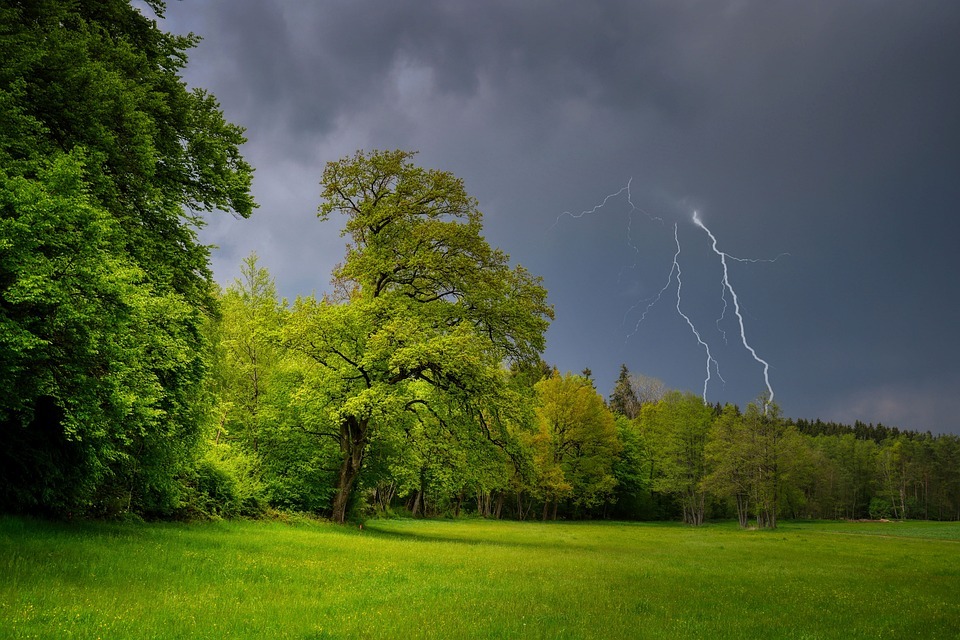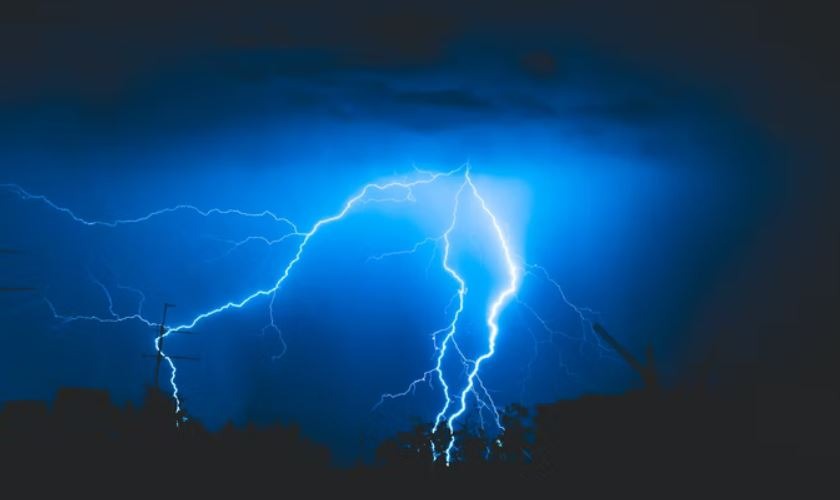How Lightning Rods Protect Buildings and Infrastructure
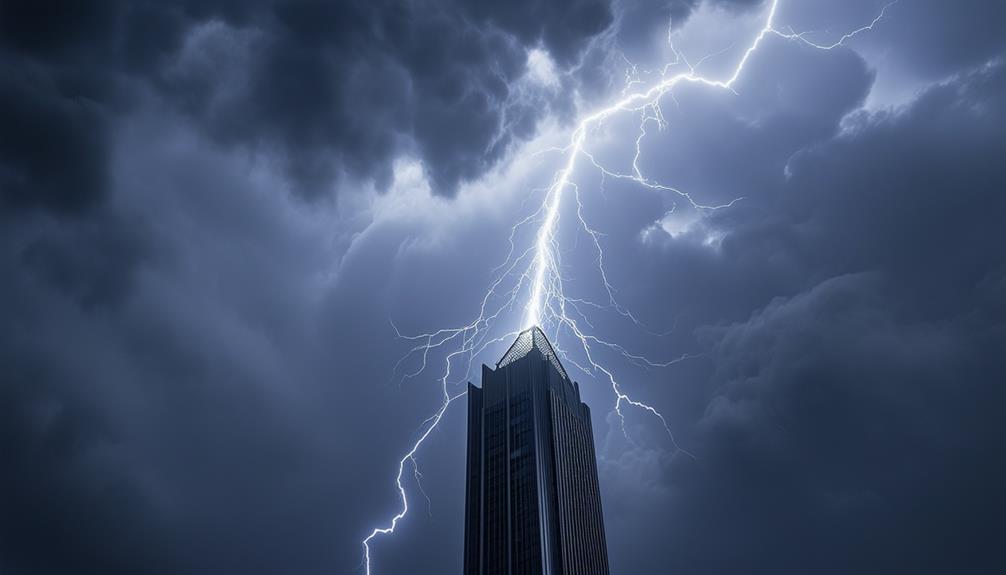
When you think about lightning rods, you might picture a simple metal rod on a rooftop, but their function is far more sophisticated and crucial. These devices don't just attract lightning; they safely guide the potentially devastating electrical energy into the ground, protecting both the structure and its occupants.
Without such a system, a single lightning strike could cause significant damage and chaos. Curious about how these unassuming rods achieve this essential task? There's much to learn regarding their history, installation, and the science behind their protective capabilities.
What Is a Lightning Rod?
A lightning rod is a metallic device installed on buildings to attract and safely redirect lightning strikes. Designed to channel the immense electrical energy from a lightning strike directly into the ground, it helps prevent structural damage. Typically made of conductive materials like copper or aluminum, a lightning rod features protruding points that serve as the initial contact for lightning.
When integrated into a building, a lightning rod becomes part of a comprehensive Lightning Protection System. This system includes capture systems, down conductors, grounding systems, and surge arrestors.
The lightning rod acts as the capture system, attracting the lightning strike. Down conductors then safely guide the electrical discharge towards the ground. Grounding systems disperse this energy into the earth, while surge arrestors protect internal electrical systems from voltage spikes.
History of Lightning Rods
Benjamin Franklin's invention of the lightning rod in 1753 marked a pivotal advancement in protecting buildings and infrastructure from lightning strikes. His groundbreaking work began with the renowned kite and key experiment, which demonstrated the electrical nature of lightning.
This discovery led to the development of the lightning rod, a simple yet effective device designed to safely direct the electrical energy of lightning into the ground.
Before Franklin's innovation, buildings were highly susceptible to fires and damage from direct lightning strikes. The introduction of the lightning rod revolutionized the protection of homes, barns, and other structures in the 18th century, making it a fundamental component of lightning protection systems.
Over time, the use of lightning rods became widespread, being installed on churches, homes, and public buildings, significantly reducing the incidence of fires and structural damage. The history of lightning rods highlights their essential role in the evolution of building safety. Today, this straightforward device remains crucial in safeguarding modern infrastructure from the unpredictable power of lightning.
Lightning Strikes Effects
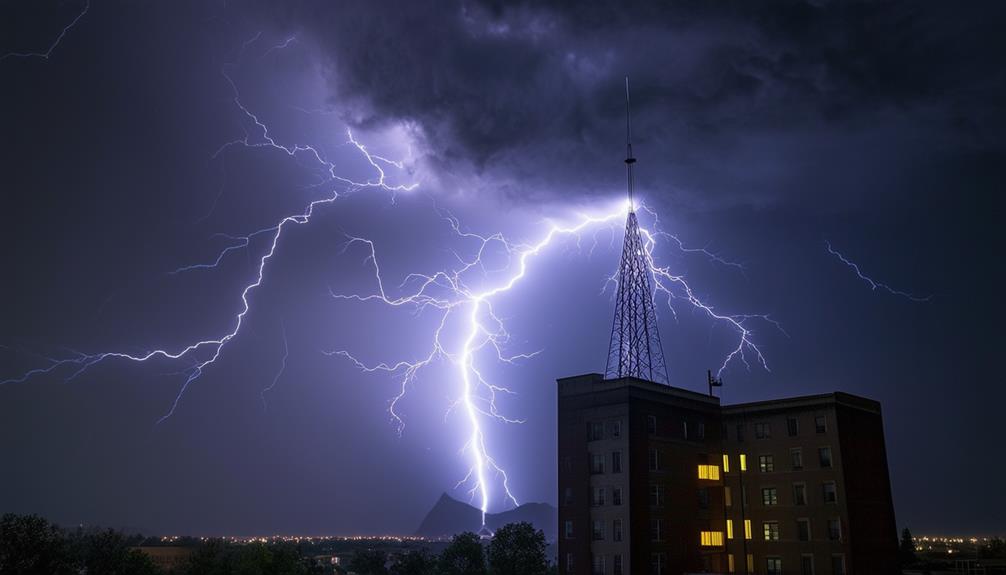
Lightning strikes release immense energy that can cause significant thermal and physiological impacts on both structures and living beings. When lightning strikes, it can reach temperatures up to 20,000°C within the lightning channel, causing materials to melt or even catch fire. This extreme heat poses serious risks to buildings, underscoring the need for robust protection measures.
For living beings, the effects of lightning strikes can be devastating. Step and contact voltages can cause severe injuries or even death. Step voltage occurs when the ground is electrified, and you step into the radius of the electrical current, while contact voltage happens when you touch an electrically charged object. These physiological impacts emphasize the importance of safety measures.
Regulations have been established to ensure structures and individuals are well-protected from lightning's effects. Lightning produces both luminous and auditory phenomena, known as lightning and thunder, which are awe-inspiring but also hazardous. The thermal and physiological impacts highlight the significance of protection measures to safeguard both buildings and inhabitants.
Proper protection from lightning strikes involves adherence to these regulations and the implementation of effective safety measures. This ensures that both structures and living beings are shielded from the potentially disastrous consequences of lightning strikes.
How Lightning Rods Work
Understanding how lightning rods function helps us appreciate their role in protecting buildings and infrastructure from the destructive force of lightning strikes. A lightning rod is a key component of a lightning protection system, designed to attract and safely manage the energy of a lightning bolt.
When a lightning strike occurs, the rod intercepts the bolt and channels its energy through conductive materials such as copper or aluminum cables. These cables safely carry the immense electrical energy—millions of volts and thousands of amps—down into the ground, dispersing it harmlessly.
By providing a controlled path for the electrical discharge, lightning rods mitigate the risk of fires and structural damage. While they don't prevent lightning strikes, they manage the energy in a way that protects buildings and infrastructure.
In essence, the lightning rod is crucial for ensuring that the immense power of a lightning strike is safely diverted. This mechanism is vital for safeguarding property against the unpredictable and often catastrophic effects of lightning.
Types of Lightning Rods
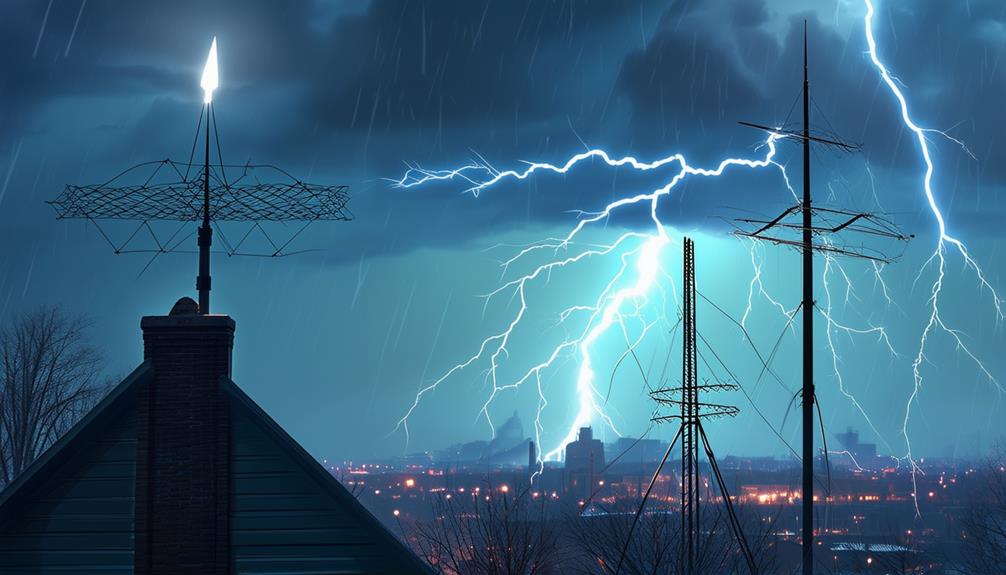
Among the different types of lightning rods, Franklin rods, Faraday cages, and ESE rods are some of the most commonly used for effective lightning protection. Each type offers distinct advantages for safeguarding structures from lightning strikes.
Franklin rods, the oldest type, are simple yet highly effective. They attract lightning strikes and direct the electrical energy safely to the ground, thereby preventing damage. Faraday cages provide comprehensive protection by enclosing the entire structure in a conductive mesh. This ensures that the lightning current is distributed evenly around the exterior, keeping the interior safe.
For more advanced protection, consider ESE (Early Streamer Emission) rods. These rods initiate an upward streamer earlier than traditional rods, offering protection radii of up to 80 meters in level I protection zones. ESE systems are efficient, easy to install, cost-effective, and comply with international standards, ensuring quality and reliability.
Incorporating any of these lightning rods into your external protection system is essential for safeguarding buildings and infrastructure from lightning damage. Selecting the right type can greatly enhance your structure's resilience to lightning strikes.
Protection for Tall Structures
Protecting tall structures like skyscrapers and towers involves strategically placing multiple lightning rods to ensure complete safety. For example, the Space Needle in Seattle employs 25 lightning rods to cover every part of the building. By situating these rods atop crowns and spires, you create a comprehensive protection system that minimizes the impact of lightning strikes.
Proper spacing of the lightning rods is crucial to effectively intercept and safely divert lightning into the ground. It's important to note that lightning rods don't prevent strikes; instead, they manage the energy to protect the building from damage.
The primary goal of these protection systems is to redirect the electrical energy of lightning away from vulnerable parts of the structure. By channeling the energy downward to the ground, the rods prevent harm to the building. Therefore, every part of the building, particularly the highest and most exposed areas, should be considered.
Installation Best Practices
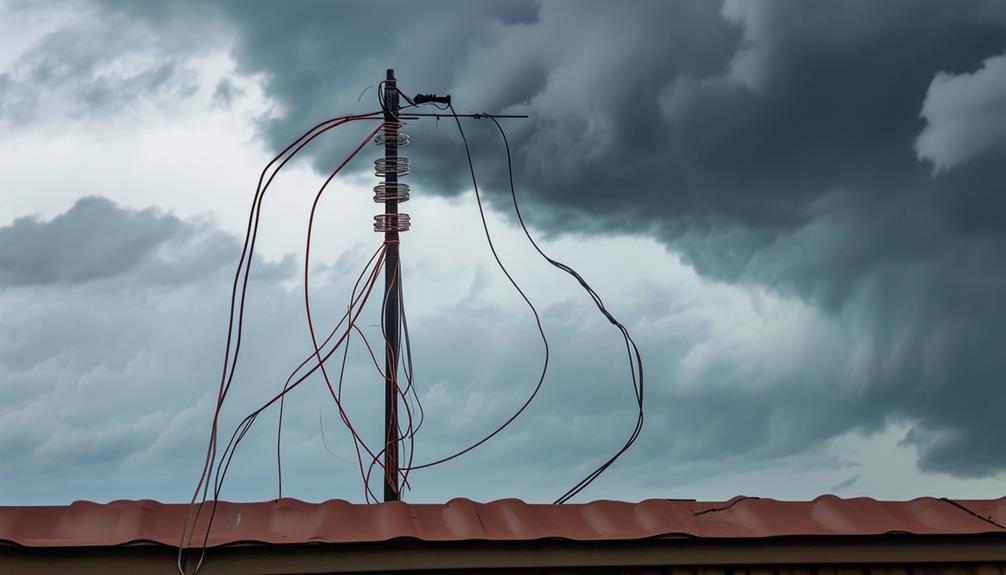
When installing lightning rods, position them at the highest points of the structure to effectively attract and dissipate lightning strikes. Use conductive materials like copper or aluminum to efficiently conduct electricity away from your building and into the ground.
Adhering to safety standards and requirements is crucial for the system's proper functioning. Annual visual inspections, as recommended by UL 96A and NFPA 780, help maintain the system's functionality. Pay special attention to vulnerable areas such as chimneys, flagpoles, roof edges, and water tanks during installation.
Refer to this quick reference table for installation best practices:
| Step | Materials | Considerations |
|---|---|---|
| Positioning | Copper or aluminum | Highest points of structure |
| Material Selection | Copper or aluminum | Conductivity and durability |
| Integration | Copper or aluminum | Blend with building aesthetics |
| Vulnerable Areas | Copper or aluminum | Chimneys, flagpoles, roof edges, tanks |
| Inspections | Visual checks | Annual, per UL 96A and NFPA 780 |
The design of the lightning protection system should harmonize with the building's aesthetics, ensuring both functionality and visual appeal. By following these best practices, you will effectively protect your building from lightning strikes while maintaining compliance with relevant safety standards and requirements.
National Safety Standards
To ensure compliance with national safety standards when installing lightning protection systems, it's crucial to follow best practices during installation. Conducting regular inspections and maintenance is also essential. This approach minimizes risks and protects infrastructure from lightning strikes.
Compliance With Regulations
Securing your lightning protection system in compliance with national safety standards is crucial for safeguarding your building against lightning strikes. Organizations such as the Lightning Protection Institute, NFPA, and UL establish these standards to ensure the proper installation and functionality of your system. Adhering to these guidelines minimizes the risks associated with lightning strikes.
Compliance with national safety standards isn't just about following regulations; it's about ensuring your building is protected from harmful electrical surges and potential fires. Lightning often enters structures through wires and pipes, and these standards ensure the safe dispersion of energy into the ground, preventing significant hazards.
Additionally, national safety standards mandate the use of surge protection devices for power, data, and communication lines, as well as for vulnerable appliances. This requirement mitigates damages caused by lightning-induced surges, safeguarding both your infrastructure and the occupants inside.
Installation Best Practices
Adhering to national safety standards during the installation of lightning protection systems ensures your building is effectively safeguarded against lightning strikes. Compliance with guidelines set by organizations like the Lightning Protection Institute and the National Fire Protection Association ensures that your installation is both safe and efficient.
By following these standards, you ensure that lightning rods intercept and safely disperse strikes to the ground, thereby protecting your building. Additionally, compliance with Underwriters Laboratories regulations is crucial. These regulations certify that the installation meets rigorous safety criteria, minimizing risks and enhancing the system's longevity.
Proper installation involves strategically placing lightning rods, connecting them to a network of conductors, and ensuring a reliable path to the ground. This setup significantly reduces the risk of fires, structural damage, and electrical surges caused by lightning strikes.
Adhering to industry standards during installation not only protects your building now but also ensures the system's durability and functionality for years to come. Cutting corners or neglecting these guidelines can lead to ineffective protection, putting your building and its occupants at risk. Always prioritize compliance with national safety standards for optimal protection.
Inspection and Maintenance
How often do you inspect your lightning protection system to confirm it meets national safety standards? Industry standards such as UL 96A and NFPA 780 recommend annual visual inspections. These inspections are crucial for identifying any signs of wear and tear on components, including air terminals, conductors, and fasteners.
Regular evaluations ensure that your system remains in optimal condition and can effectively protect your building. In addition to yearly checks, comprehensive maintenance inspections should be performed every five years or following any significant damage. This thorough review ensures the integrity of the system and its components.
During these inspections, every part of the system is carefully examined to confirm nothing is compromised. If any issues are found, recommendations for repairs and updates will be provided to keep your system compliant with current safety standards.
System Maintenance and Inspection
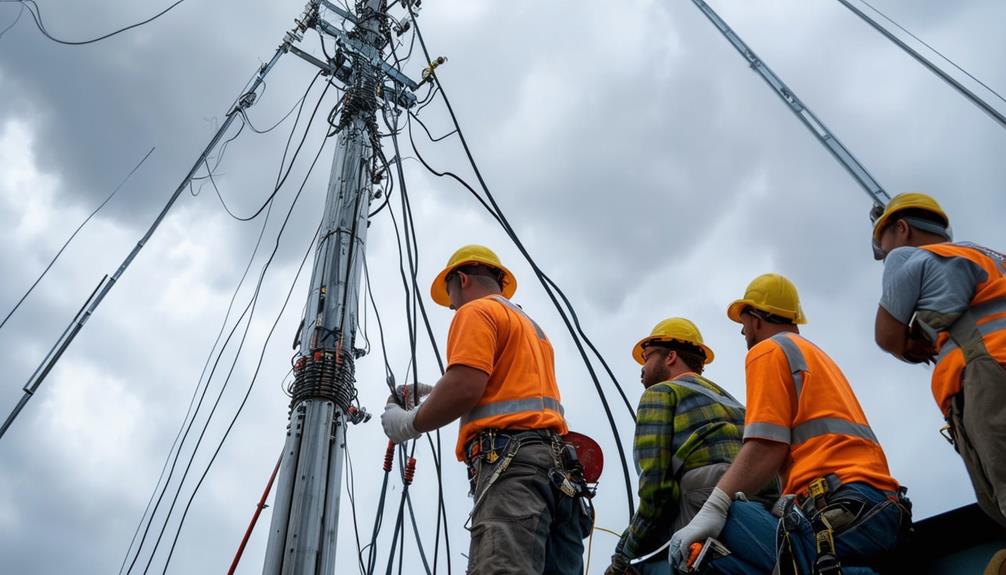
To ensure your lightning protection system remains effective, conduct regular visual inspections and follow a component maintenance schedule. Adhere to industry standards such as UL 96A and NFPA 780 to identify any damage or wear and keep your system in optimal condition.
Regular Visual Inspections
Regular visual inspections are crucial for maintaining the effectiveness of your lightning protection system. The National Fire Protection Association (NFPA) stresses the importance of these inspections to ensure your system provides optimal protection. By adhering to industry standards such as UL 96A and NFPA 780, you can keep your system in peak condition.
Focus on the following areas during your inspections:
- Air Terminals: Inspect for any damage or corrosion. As the primary defense against lightning strikes, their integrity is critical.
- Conductors: Ensure they're securely fastened and free from breaks or wear. Conductors safely channel lightning to the ground, so any compromise affects the entire system.
- Fasteners: Check all fasteners and connections for looseness or corrosion. Faulty fasteners can lead to component failure, jeopardizing the system.
Annual visual inspections, as recommended by standards, help identify and address issues before they escalate. Additionally, it's prudent to conduct inspections after significant storms or incidents that might damage the system. Regular checks and timely repairs maintain the effectiveness of your lightning protection system, thereby securing your building and infrastructure.
Component Maintenance Schedule
Establishing a component maintenance schedule is crucial for ensuring that your lightning protection system remains effective and compliant with safety standards. It's essential to adhere to national safety guidelines, such as UL 96A and NFPA 780, which recommend annual visual inspections of all system components. These routine checks help identify any wear, aging, or weathering that could compromise the system's functionality.
In addition to annual visual inspections, conduct comprehensive maintenance inspections every five years or after any significant system damage. During these detailed inspections, evaluate all critical components, including air terminals, conductors, and fasteners. Ensuring that these components are in good condition is necessary for maintaining the system's integrity and effectiveness.
Compliance With Standards
Ensuring your lightning protection system complies with standards such as UL 96A and NFPA 780 requires adhering to a structured schedule of inspections and maintenance. Annual visual checks are recommended to confirm that components like air terminals, conductors, and fasteners are intact and effective. Additionally, it's crucial to conduct comprehensive maintenance inspections every five years or after any significant damage occurs to ensure the system meets current safety requirements.
To maintain compliance and effectiveness of your lightning protection system, follow these guidelines:
- Annual Visual Inspections: Inspect for visible damage or wear on components and ensure they remain securely fastened.
- Five-Year Maintenance Inspections: Conduct a thorough evaluation to identify and address any parts that need repair or replacement according to updated safety standards.
- Post-Damage Assessments: After significant events such as lightning strikes or severe weather, promptly examine the system to identify and rectify any damage.
Adhering to these steps ensures your system not only meets but exceeds the safety and performance requirements of lightning protection standards, thereby safeguarding your building and infrastructure.
Importance of Surge Protection
Surge protection is crucial for every building to safeguard against the damaging effects of electrical surges, particularly those caused by lightning strikes. When lightning strikes, it can induce massive electrical surges by traveling through power lines, data cables, and phone lines. Without appropriate surge protection, these surges can cause severe damage to appliances, data systems, and even gas lines.
To ensure effective surge protection, adherence to national safety standards set by the Lightning Protection Institute, NFPA, and UL is essential. These standards offer guidelines for the correct installation of surge protection devices, which are vital for safely diverting excess electrical energy into the ground. This preventive measure protects against costly damages and operational downtime.
Key areas requiring surge protection include:
| Key Area | Common Impact | Protection Measure |
|---|---|---|
| Power Lines | Appliance damage | Surge protectors |
| Data Lines | Data corruption/loss | Data line protectors |
| Phone Lines | Communication disruption | Phone line protectors |
| Appliances | Component failure | Whole-home surge protectors |
| Gas Lines | Potential fire hazard | Specialized gas line protectors |
Incorporating surge protection into your lightning protection system is not only about compliance but also about ensuring the safety and functionality of all critical systems within your building.
Conclusion
By understanding how lightning rods work and ensuring their proper installation and maintenance, you can effectively protect your buildings and infrastructure. These systems provide a safe path for lightning energy, reducing the risk of structural damage and fires.
Always adhere to national safety standards and incorporate surge protection to enhance the system's effectiveness. Regular inspections and maintenance will ensure that your lightning protection system remains reliable, safeguarding your property for years to come.



